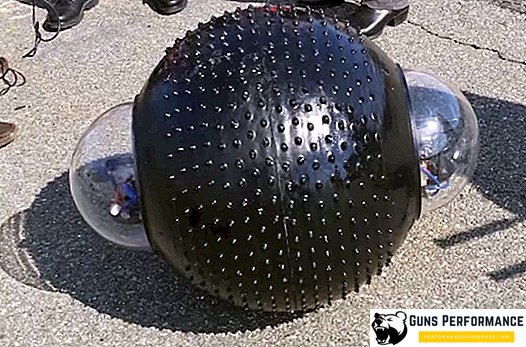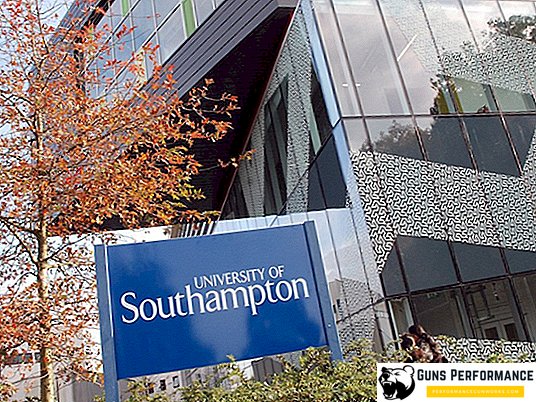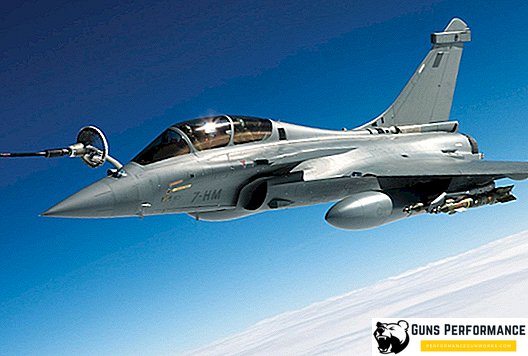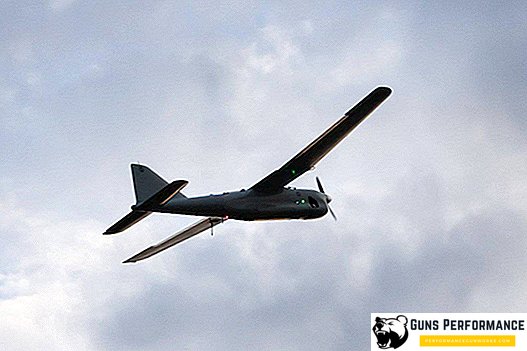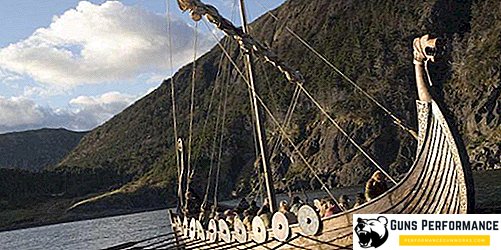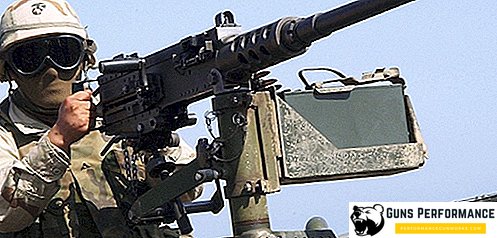GAZ-46 is a Soviet-made machine assembled by a Gorky enterprise for five years (1953-1958). On arms in army designated "MAV" - the small car waterfowl. The technique was used in reconnaissance operations and for the implementation of various types of work on water bodies.
General information GAZ-46

The Great Patriotic War gave the military leadership a lot of thought for thought. Army transport was significantly inferior to foreign counterparts, and some species were not at all. Soviet engineering did not produce floating machines that solved many strategic tasks.
During the war, according to the program of allied support of the USSR, he received from Canada and Britain parties DUKW and Ford GPA, which were all-wheel drive six-wheel and four-wheel amphibians, respectively. They were used to transport goods and people across rivers in the Far East. Cars liked the military leadership, so they were included in the rearmament plan of the army. After the end of hostilities, the most experienced engineers in the country engaged in the creation of floating cars.
The priority goal was the production of passenger amphibians, which could be used by the leaders of various military units. For the development of the GAZ-46 used some technical units Ford GPA.
The history of the creation of amphibians GAZ-46
After the end of the Second World War, NAM specialists began developing a floating machine. They took the popular GAZ-67 jeep, the production of which has been well-established in recent years, as the basis for their project. Technical units of the Soviet product decided to combine with the American Ford GPA, which has been in service with the Soviet army since 1942. The designers planned to substantially recycle the foreign equivalent, adapting to the conditions of our country.
NAMI-011

At the end of July 1948, experts from the Engineering Committee of the Armed Forces of the USSR approved all the requirements and wishes for a new design. She was given the name NAMI-011, and in the army the equipment was listed under the symbol "MAV". A new amphibian was planned to be used for transportation over land and water of small loads and small groups of people (up to 5 people), towing boats, small trailers, pontoon and other floating means used in the USSR.
The upcoming serial production of a new product was accompanied by one problem: the GAZ-67, which was the basis, was created in the war years and was morally obsolete by the early 1950s. Over the past few years, it was planned to replace it with a promising 69th model. Engineers NAMI did not worry, so in the late spring of the 49th year, they collected the first prototypes, which were sent to the factory tests. In the summer of the same year, the equipment underwent field testing, and in the fall, interdepartmental tests in Leningrad. The car showed excellent results in all instances. All designers were awarded a state award for good work, as instructed by the commander in chief.
After some time, one prototype NAMI-011 and its technical documentation was sent to the Gorky Automobile Plant. It was planned that after a small refinement of the device will begin a mass production of promising amphibians. One more problem was added to the obsolete basis of technology: NAMI engineers did everything in a hurry, which negatively affected the quality. Drawings and other technical documentation had a huge number of errors, which excluded the possibility of conveyor production.
Despite the dissatisfaction of local specialists, in those years it was impossible to refuse to fulfill the state order, which received the Stalin Prize. A special group was assembled at the plant, the head of which was Kreschuk. She was instructed to make the necessary corrections to the documents sent from Moscow. In 1944, the company had already planned to produce a floating vehicle based on GAZ-67, but this idea was soon abandoned because of its futility. In NAMI, errors during the development were corrected by various methods that were not suitable for mass production, which Kreshchuk took to correct. At the same time, the management of the Gorky Automobile Plant favored the 69th model, since its development initially allowed the possibility of conversion into a waterfowl machine.
The appearance of GAZ-46
During the year, Kreshchuk’s team made the required changes to the technical documentation. The final version could be sent to the conveyor for serial production. In parallel with the work on NAMI-011, a different composition of designers, led by experienced specialists, worked on the development of the amphibian, which was based on the technical components of the innovative GAZ-69 off-road vehicle. New development was given the name GAZ-46 MAV. The management of the company, seeing the serious contribution of employees to the development of two competing projects, planned to release them simultaneously for testing. In this case, the main customer (USSR Army) could choose the most modern option.
In 1951, the general testing of the modified car of the Research Automotive and Automobile Institute was held. He was followed by experts of the Engineering Committee of the USSR Armed Forces. All tests of the GAZ-011 was successful, Kreshchuk managed to achieve weight reduction, improved maneuverability, increase in maximum speed and increase in the working life of the main units. The problem of launching mass production lay in the refusal of the Gorky-based enterprise to produce the 67th model due to the production of a more modern GAZ-69 on the conveyor. It was impossible to make a choice in favor of the main competitor - GAZ-46 - because of the sympathy of the military leadership for the 11th amphibian. Confusion and uncertainty lasted until 1952, while Kreschuk in a secret letter did not report to Stalin about the problem with floating equipment at the plant.
The reaction of the commander in chief was not long in coming. Stalin personally intervened in the situation, dismissing and lowering many leaders and officials of the enterprise. Due to the poor quality of NAMI-011, the decision to award the award to the designers was canceled. In the end, the Gorky plant made a choice in favor of GAZ-46. In 1953, 68 machines of the 11th model rolled off the assembly line, which fully corresponded to the production plan for this year.
GAZ-46 design

Specifications:
- Length - 4.9 m;
- Height - 1.8 m;
- Width - 1.9 m;
- Wheelbase - 2.3 m;
- Wheel formula - 4x4;
- Clearance - 28 cm;
- Weight - 1.8 tons;
- The volume of the power unit - 2.112 l;
- Power - 55 hp at 3.6 thousand revolutions;
- Torque (max) - 125 Nm at 2 thousand revolutions;
- The maximum speed on land / afloat is 90 km / 9 km.
Body

In order to be able to navigate through water, the designers on the box frame assembled a welded steel housing. For additional sealing, doors were excluded from its device. The body consisted of three parts, which were separated from each other by vertical partitions. The power unit and transmission system were located in the front compartment. Transport controls and passenger seats were located in the central part. Carried goods, spare parts and service tools were put in the rear compartment.
On the nose of the equipment was a volt-breaker shield. The driver pushed him before diving into the water. It was designed to protect against the ingress of water into the engine cooling and cockpit connectors. He also contributed to the exclusion of the possibility of bury transport in the water. An accessory included a bollard for towing a car through the water and a capstan for a rescue buoy. Lever dampers pushed beyond the hull. Spare wheels placed in the rear.
Engine compartment and management

The petrol engine from GAZ-20M, which had four cylinders, was responsible for the movement of the car. From GAZ-69 designers took hodovka and transmission mechanisms. The power plant worked in conjunction with the mechanical type gearbox. She had four steps: three front and one rear. Also in the design included a transfer box with two speeds.
When switching to the water, the motor was replaced by a three-blade propeller. For his work was responsible cardan shaft, part of the design razdatki. Instead of the standard steering mechanism, a water-steering wheel was used to adjust the direction on the water. He was in a jet of water that formed the screw. For GAZ-46 amphibians have developed special wheels. The driver, driving off-road, could remotely reduce tire pressure to increase all terrain.
Other nodes
The designers made all the wiring tight, including the ignition distributor. No additional protection was required when overcoming water obstacles. To eliminate the possibility of flooding the muffler and the exhaust pipe, they were moved to the front. One of the main drawbacks was the strong noise from the muffler. In combat operations, he revealed the location of the car. A successful construction solution was the transfer of the fuel filler neck to the nose compartment. The crew could carry out refueling vehicles directly afloat.
Salon

Inside the body there was no beautiful design. Since the main customer was the army, the dashboard and related elements turned out to be simple, because their main task was to inform the driver about the state of transport. The low level of comfort for the crew turned out for similar reasons. In appearance, the amphibian turned out to be similar to a boat. The dashboard was equipped with a speedometer, a tachometer and an indicator of water penetration into the cabin.
The driver controlled the gearbox with the levers to his right. Pedals got an unusual shape. They were placed as close as possible to each other to fit into one hole (made to increase tightness). The windshield was attached to a flip open frame. Her crew was raising for the time of movement in the water, to protect themselves from the ingress of water into the cabin. To protect against precipitation it was possible to install an awning. The crew was located on five seats - two separate front and a combined sofa in the back. Rear seats had no regulatory mechanisms. Fuel filter moved to the salon. This simplified repair work.
What can be concluded?

GAZ-46 - an excellent development of the Soviet engineering, which carried a good service for five years in various military industries. Some copies were exported to the countries that signed the Warsaw Pact.
In 1958, the production capacity was transferred to the Ulyanovsk enterprise UAZ. However, the release did not last long due to the impossibility of collecting amphibians due to the lack of necessary spare parts for the assembly of technical units. Soon the 46th model was replaced with new BRDM. According to unofficial data, in five years about 650 copies were collected.


